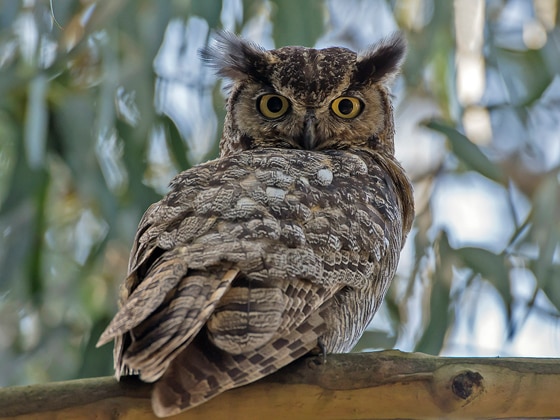Shakespeare’s Birds Walk & Talk
By Mary Ann Koory
In 2010, Linda Swanson, I, and friends attended a thrilling CalShakes production of Macbeth in Orinda. As we took our seats, twilight filling the bowl of the Bruns Amphitheater, Linda said, “Did you hear that?” As a non-birder I am used to Linda noticing the presence of birds no matter where we are. Perhaps your friends have remarked on the same thing about you. It’s as if there is another world co-existing with our ordinary, urban world, one that we non-birders are only intermittently aware. I looked up from setting out cheese and crackers and listened. A Great Horned Owl hooted.

In about 15 minutes, Lady Macbeth would pace across the stage, waiting for her husband to say that he had stabbed King Duncan. As she waits, she hears a noise – but it’s not Macbeth. “Hark! Peace!/It was the owl that shriek’d, the fatal bellman . . .” (2.2.3-4) she says to herself. The sound of the owl reminds Lady Macbeth of the bell that rang in Renaissance towns to announce a death. She, waiting for news of a murder that violates social connections, hears the owl calling like the bell that signals a community to pause and mourn the loss of a neighbor.
Most of us have no idea what a “fatal bellman” is without a footnote. Over 400 years separate us from Shakespeare, the customs of rural England, and the commercial theaters of London. But when the actress spoke Shakespeare’s words, her voice, the sounds of a Great Horned Owl in the 21st-century Orinda twilight, the play-acted owl outside a castle in medieval Scotland, the “shriek” described by a 16th-century playwright for his rowdy city audiences, and the solemn tone of a church bell in Renaissance England all resonated together in the same moment.
Linda and I, both English teachers, were enchanted by the way the imaginary and the real owl connected us to Shakespeare and our world to Shakespeare’s natural world. Since then, Lesley and Bob Currier at Marin Shakespeare Company in San Rafael have given us the opportunity to explore connections between the metaphorical birds that appear in Shakespeare’s plays and the literal birds that appear here in California where his plays are performed. Since 2013, Linda has led a bird walk through the lovely Dominican University campus where Marin Shakespeare’s Forest Meadows Amphitheater is located, afterwards I, over dinner in the Amphitheater, talk about the birds that will appear in the Shakespeare production that follows.
Shakespeare grew up in rural Stratford, where birds, deer, rodents, trees and flowers were familiar parts of his landscape. But the urban London where he made his fortune also significantly included the natural landscape. The theatres in Southwark, for instance, were built in undeveloped meadows and marshland. The birds that appear in Shakespeare’s plays are not purely literary figures – they are sensory memories as well as imaginative visions, and as clearly as anything in his plays, birds give us access to the world he moved through.
Crossing the Thames to go to work at the Globe, Shakespeare would have seen water birds, like cormorants, on the river. (You can see cormorants on the Thames today, if you go to YouTube.) The delightful Marin Shakespeare production of Love’s Labour’s Lost (2017) led us to discover that cormorants were proverbial for their appetites, which explains this wonderful phrase in the first scene: “cormorant devouring time” (time devours everything like a hungry cormorant eating fish). In the 16th century, the English tamed cormorants for sport fishing. To collect the fish the tame cormorants caught, the owners put a ring around the birds’ long necks to keep them from swallowing. King James kept trained cormorants and took them on his fishing expeditions. Sure enough, on one of our walks Linda spotted a Double-crested Cormorant, beautiful and wild, and happily not in the possession of any royal sportsman.

Here is the cumulative bird species list, in taxonomic order, of birds Linda and the group spotted on our walks (2013-2018). There are 30 species, and 1 swallow species (either Tree or Violet-green Swallow):
Canada Goose
Double-crested Cormorant
Turkey Vulture
Red-shouldered Hawk
Mourning Dove
Band-tailed Pigeon
Anna’s Hummingbird
Allen’s Hummingbird
Nuttall’s Woodpecker
Western Wood-Pewee
Pacific-slope Flycatcher
Black Phoebe
California Scrub Jay
American Crow
Tree/Violet-green Swallow
Chestnut-backed Chickadee
Oak Titmouse
Mary Ann Koory, Ph.D., taught Shakespeare to undergraduates at San Francisco State University for many years, and worked as a dramaturg for Marin Shakespeare.
Join Linda and Mary Ann for the Bird Walk & Talk on Saturday, September 21: 5:30 pm for a free walk around Forest Meadows looking and listening for native species, then, join the Shakespeare Dinner at 6:30 pm for a talk about birds in Shakespeare. The play, A Midsummer Night’s Dream begins at 8:00 pm. Forest Meadows Amphitheatre, Dominican University, San Rafael. Marin Shakespeare Company, dinner and play tickets https://www.marinshakespeare.org/ Questions: contact Linda Swanson at LSwanson@gmail.com.
